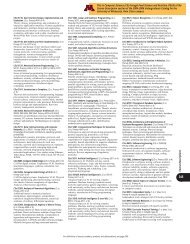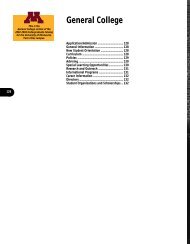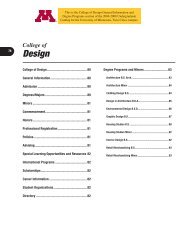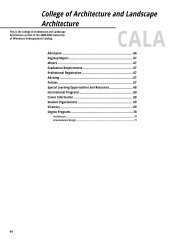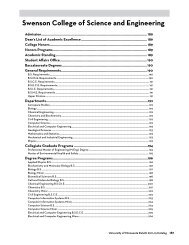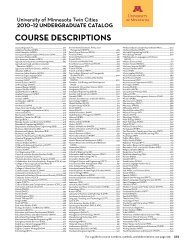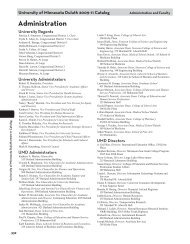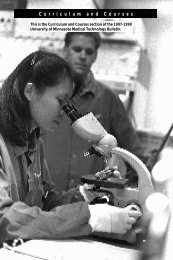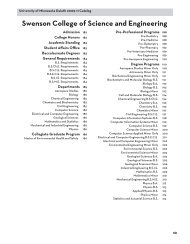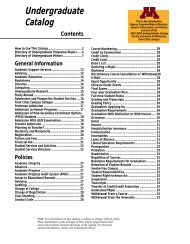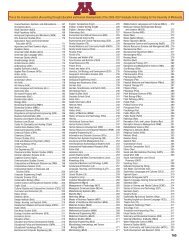sites). Imaging technologies based on propagation ofelastic waves such as ultrasonic/resonant frequencymethods, seismic surveys, <strong>and</strong> acoustic emissionmonitoring. Lecture, lab.CE 5541. Environmental Water Chemistry. (3 cr;A-F only. Prereq–3501, Chem 1021, Chem 1022)Introduction to water chemistry. Physical chemicalprinciples, geochemical processes controllingchemical composition of waters, behavior ofcontaminants that affect the suitability of water forbeneficial uses.CE 5542. Experimental Methods in EnvironmentalEngineering. (3 cr; A-F only. Prereq–3501, Chem 1021,Chem 1022)Tools necessary to conduct research in environmentalengineering <strong>and</strong> chemistry. Theory of operation ofanalytical equipment. Sampling <strong>and</strong> data h<strong>and</strong>lingmethods, statistical analyses, experimental design,laboratory safety. Lecture, laboratory.CE 5551. Environmental Microbiology Laboratory.(4 cr; A-F only. Prereq–3501, [upper div or grad]student)Role of microorganisms in environmentalbioremediation, pollution control, water/wastewatertreatment, biogeochemistry, <strong>and</strong> human health. Basicmicrobiological techniques: isolation, identification/enumeration of bacteria, BOD, biodegradationkinetics, disinfection. Lecture, lab.CE 5581. Water Resources: Individuals <strong>and</strong>Institutions. (3 cr; A-F only)Control of water resources by natural systemfunctions, user actions, <strong>and</strong> influence of social,economic, <strong>and</strong> political institutions. Water resourcepolicy in the United States. Case studies (e.g., flood/drought management).CE 5591. Environmental Law for Engineers. (3 cr;A-F only. Prereq–upper div IT or grad or #)Environmental regulatory law relevant to civil <strong>and</strong>environmental engineering; specific provisions offederal statutory <strong>and</strong> regulatory laws such as NEPA,CWA, RCRA, CAA, <strong>and</strong> CERCLA.Classical Civilization(ClCv)Department of Classical <strong>and</strong> Near EasternStudiesCollege of Liberal ArtsCLCV 1201. The Olympic Games. (3 cr)Surveys the Olympic Games (776 B.C. to A.D. 338)<strong>and</strong> other ancient athletic festivals, including thosefor women participants. Greek art <strong>and</strong> literature serveas basic sources. Comparisons are made with modernathletic events.CLCV 3201. The Olympic Games. (3 cr)The Olympic Games (776 B.C. to A.D. 338) <strong>and</strong>other ancient athletic festivals, including those forwomen participants. Greek art <strong>and</strong> literature serve asbasic sources. Comparisons are made with modernathletic events.CLCV 3340. Practicum in Archaeological Field <strong>and</strong>Computer Techniques. (3 cr. Prereq–ClCv major or # orone <strong>course</strong> in ancient art <strong>and</strong> archaeology)Methods used for excavation of Old <strong>and</strong> New Worldsites. Meets at archaeometry/computer lab for part ofthe semester <strong>and</strong> at a selected site in Minnesota forday-long sessions for 9 to 10 weeks.CLCV 3510. Great Books. (3 cr [max 9 cr]. Prereq–Jr orsr or #)Intensive study of major works of classical antiquity<strong>and</strong> later (written in or translated into English),related by kind, theme, style, or perspective. Sometimesincluding works from non-Western cultures.CLCV 3711. Classics of Literary Criticism. (3 cr.Prereq–1 <strong>course</strong> in literature, 2nd <strong>course</strong> in literature orphilosophy or #)Principles of criticism as expounded <strong>and</strong> employedin major critical works by writers such as Plato,Aristotle, Horace, Longinus, Sir Philip Sidney, JohnDryden, Samuel Johnson, David Hume, WilliamWordsworth, Samuel Taylor Coleridge, <strong>and</strong> T. S.Eliot.CLCV 3940. Proseminar: Classical Traditions inWestern Culture. (3-4 cr [max 6 cr]. Prereq–ClCv majoror #)The nature of Greco-Roman classical traditionsmanifested in various cultural spheres: language <strong>and</strong>literature, fine arts, history, science, philosophy,theology, <strong>and</strong> other disciplines; the political, social,educational, <strong>and</strong> religious life of society. Theperspective, scope, breadth, <strong>and</strong> depth of the <strong>course</strong>will vary.CLCV 3950. Topics in Classical Civilization. (3-4 cr[max 9 cr])Topics specified in the Class Schedule.CLCV 3993–3996. Directed Studies in ClassicalCivilization. (1-4 cr)Classics (Clas)Department of Classical <strong>and</strong> Near EasternStudiesCollege of Liberal ArtsClas 1001. Ancient Greece: Poet <strong>and</strong> Hero in the Ageof Homer. (3 cr)Homer <strong>and</strong> his epic poetry; Trojan war; Greek lyricpoets (Sappho <strong>and</strong> Pindar); early Greek philosophy.Clas 1002. Ancient Greece: The Golden Age ofAthens. (3 cr)Emergence of democracy in shadows of two brutalwars: one foreign, one civil. Democracy, war, empire<strong>through</strong> lens of tragedy, comedy, art from 5thcenturyAthens.Clas 1003. Ancient Greece: Alex<strong>and</strong>er <strong>and</strong> the East.(3 cr)Achievements of Alex<strong>and</strong>er the Great <strong>and</strong> their effecton the Greek-speaking world; Greek colonization ofEgypt; Hellenistic art, literature, <strong>and</strong> philosophy.Clas 1004. Ancient Rome: Power, Politics, <strong>and</strong> theRoman Republic. (3 cr)The Roman Republic from its origins to Caesar’sdeath.Clas 1005. Ancient Rome: The Roman Revolution.(3 cr)Transition from republic to empire; politicalstrategies of Augustus (the first emperor). “Goldenage” of Latin literature; the monuments.Clas 1006. Ancient Rome: The Age of Nero. (3 cr)The Roman Empire. “Silver age” of Latin literature,rise of Christianity. Art/architecture.Clas 1023. The Age of Constantine the Great. (3 cr.§3023)Change/continuity in Roman Empire from secondcenturyzenith to third-century crisis, first Christianemperor (AD 306 to 337), <strong>and</strong> beyond. Replacementof classical paganism by Christianity. Beginnings ofmonasticism. Superpower relations between Roman,Persian empires.Clas 1024. The Age of St. Augustine of Hippo. (3 cr.§3024)Cultural diversity (A.D. 363 to circa A.D. 500).Replacement of Roman Empire in Western Europeby barbarian kingdoms, consolidation ofConstantinople as capital in the East. Literature, art,thought resulting from new dominance ofChristianity, particularly Augustine of Hippo. Meetswith 3024.Clas 1042. Greek <strong>and</strong> Roman Mythology. (4 cr)Introduction to the stories <strong>and</strong> the study of Greek <strong>and</strong>Roman mythology.Clas 1042H. Honors Course: Greek <strong>and</strong> RomanMythology. (4 cr. Prereq–Honors or #)Introduction to stories/study of Greek/Romanmythology.Course DescriptionsClas 1043. Classical Archaeology: Introduction tothe Archaeology of Ancient Greece <strong>and</strong> Rome. (4 cr)Role that material culture, including art <strong>and</strong>architecture, plays in forming our picture of theClassical past. Relationship between archaeology<strong>and</strong> other disciplines dealing with the past. Study ofselected sites considers the motives <strong>and</strong> methods ofresearch <strong>and</strong> how the results are used byarchaeologists <strong>and</strong> the general public.Clas 1045. Etymology: Word Study in the Sciences<strong>and</strong> Humanities. (3 cr)English prefixes, suffixes <strong>and</strong> roots from Greek <strong>and</strong>Latin are taught <strong>through</strong> computer-assistedinstruction; techniques of word analysis. Historicaloverview of Greek <strong>and</strong> Latin; their relationship with<strong>and</strong> influence on English.Clas 1082. Jesus in History. (3 cr)Jesus of Nazareth in his original setting. Modernapproaches to the historical Jesus. Perspectives <strong>and</strong>needs of early gospel writers <strong>and</strong> effects onportrayals of Jesus. Shifting representations of Jesusin new historical <strong>and</strong> cultural situations. Meets withClas 1182.Clas 1082H. Honors Course: Jesus in History. (4 cr.§1082, §1182, §RelA 1082, §RelA 1182. Prereq–Honors)Jesus of Nazareth in his original setting. Modernapproaches to the historical Jesus. Perspectives,needs of early gospel writers. Effects of portrayals ofJesus. Shifting representations of Jesus in newhistorical/cultural situations. Meets with 1082.Clas 1083. Jesus the Jew. (3 cr. §3083, §RelA 1083,§RelA 3083, §JwSt 1083, §JwSt 3083)Historic figure of Jesus within context of firstcentury Palestinian Judaism. Main groups/institutions of Judaism at time of Jesus. Rabbinicliterature/traditions. Works describing Jesus’ life/sayings (synoptic gospels). Jesus <strong>and</strong> the Law,Messianic ideals/expectations, problem of religiousauthority. Positions regarding Rome, its authority.James <strong>and</strong> the Jerusalem Church.Clas 1148. Technical Terminology for the HealthProfessions. (3 cr)Greek <strong>and</strong> Latin prefixes, suffixes, <strong>and</strong> roots basic tothe vocabulary of health professions; taught <strong>through</strong>computer-assisted instruction.Clas 3001W. Classical Lyric <strong>and</strong> Satire. (3 cr)Greek <strong>and</strong> Roman lyric poetry; Roman satire.Clas 3008. History of Ancient Art. (3 cr)Architecture, sculpture, <strong>and</strong> painting of selectedearly cultures; emphasis on influences on thedevelopment of Western art.Clas 3023. The Age of Constantine the Great. (3 cr.§1023)Change/continuity in Roman Empire from its 2ndcenturyzenith <strong>through</strong> 3rd-century crisis, firstChristian emperor (306 to 337 A.D.), <strong>and</strong> beyond.Replacement of classical paganism by Christianity.Beginnings of monasticism. Superpower relationsbetween Roman, Persian empires. Meets with 1023.Clas 3024. The Age of St. Augustine of Hippo. (3 cr.§1024)Cultural diversity (A.D. 363 to circa 500 A.D.).Replacement of Roman Empire in Western Europeby barbarian kingdoms, consolidation ofConstantinople as capital in the East. Literature, art,thought resulting from new dominance ofChristianity, particularly Augustine of Hippo. Meetswith 1024.Clas 3035. Classical Myth in Western Art. (4 cr)An exploration of the role of myth in the visual arts<strong>through</strong> examination of major figures <strong>and</strong> stories thatbecame popular in the ancient world <strong>and</strong> havefascinated artists <strong>and</strong> audiences ever since.Clas 3070. Topics in Ancient Religion. (3 cr)Study of a specific aspect of religion in Classical <strong>and</strong>Near Eastern antiquity such as healing cults, magic<strong>and</strong> divination, Gnosticism, or prophecy <strong>and</strong>authority. Topics specified in the Class Schedule.Course Descriptions331
332Clas 3071. Greek <strong>and</strong> Hellenistic Religions. (3 cr)Greek religion from the Bronze Age to Hellenistictimes. Sources include literature, art, <strong>and</strong>archaeology. Homer <strong>and</strong> Olympian deities; ritualperformance; prayer <strong>and</strong> sacrifice; templearchitecture; death <strong>and</strong> the afterlife; mystery cults;philosophical religion; Near Eastern salvationreligions.Clas 3072. The New Testament. (3 cr)Early Jesus movement in its cultural <strong>and</strong> historicalsetting. Origins in Judaism; traditions about Jesus.The apostle Paul, his controversies <strong>and</strong> interpreters.Questions of authority, religious practice, <strong>and</strong>structure; emergence of the canon of scripture.Contemporary methods of New Testament study;biblical writings as history <strong>and</strong> narrative.Clas 3072H. Honors Course: The New Testament.(4 cr. §3072. Prereq–3172, RelA 3072, RelA 3172, honors)Early Jesus movement in its cultural/historicalsetting: origins in Judaism; traditions about Jesus;Paul, his controversies/interpreters; questions ofauthority, religious practice, structure; emergence ofcanon. Contemporary methods of New Testamentstudy; biblical writings as history/narrative. Meetswith 3072. Honors students meet weekly forrecitation section.Clas 3073. Roman Religion <strong>and</strong> Early Christianity.(3 cr)Etruscan, Republican religion. Appeal of non-Romancults. Ruler worship. Christians in Asia Minor,Egypt, <strong>and</strong> the West. Popular piety, Christian <strong>and</strong>non-Christian. Rabbinic Judaism. Varieties ofChristianity in 2nd <strong>and</strong> 3rd centuries. Influence ofGreco-Roman culture on emerging church.Constantine <strong>and</strong> Julian.Clas 3081W. Classical Epic in Translation. (3 cr. §5081)Homer’s Iliad <strong>and</strong> Odyssey; Virgil’s Aeneid; culturalcontext of epic; development of the hero; epic style;poetics of epic.Clas 3082W. Greek Tragedy in Translation. (3 cr)Origins of tragedy; ancient theatres; selected plays ofAeschylus, Sophocles <strong>and</strong> Euripides.Clas 3083W. Ancient Comedy. (3 cr)Greek/Roman comic drama (e.g., Aristophanes,Men<strong>and</strong>er, Plautus, Terence).Clas 3088. Archaeology in Biblical L<strong>and</strong>s I: OldTestament Period. (3 cr)Archaeological data relevant to the Old Testament;major sites in the Holy L<strong>and</strong> <strong>and</strong> other areas of theMediterranean <strong>and</strong> Near East. Evidence of pottery,inscriptions, manuscripts, <strong>and</strong> coins. Excavationmethods. Archaeology as a tool for study of ancientreligions.Clas 3089. Archaeology in Biblical L<strong>and</strong>s II: NewTestament Period. (3 cr)Archaeological data relevant to the New Testament;major sites in the Holy L<strong>and</strong> <strong>and</strong> other areas ofMediterranean <strong>and</strong> Near East. Evidence of pottery,inscriptions, manuscripts, <strong>and</strong> coins. Excavationmethods. Archaeology as a tool for study of ancientreligions.Clas 3142. Art of Egypt. (4 cr)Arts <strong>and</strong> architecture of Egypt from prehistoric timesto the emergence of modern Egypt, with emphasis onthe elements of continuity <strong>and</strong> of change that haveshaped Egyptian culture.Clas 3145. Advanced Greek <strong>and</strong> Roman Mythology.(3 cr. Prereq–1042 or #)Study of the different theoretical explanations ofGreek <strong>and</strong> Roman mythology.Clas 3152. Art <strong>and</strong> Archaeology of Ancient Greece.(4 cr)Introduction to the civilization of ancient Greece asrevealed <strong>through</strong> art <strong>and</strong> material culture. Casestudies of selected monuments <strong>and</strong> sites.Clas 3162. Roman Art <strong>and</strong> Archaeology. (4 cr)Introduction to the art <strong>and</strong> material culture of theRoman World: origin, change <strong>and</strong> continuity,“progress” or “decay” in the later Empire, <strong>and</strong> itslegacy to the modern world.Clas 3173. Honors Course: Roman Religion <strong>and</strong>Early Christianity. (4 cr)Etruscan, Republican religion. Appeal of non-Romancults. Ruler worship. Christians in Asia Minor, Egypt<strong>and</strong> the West. Popular piety, Christian <strong>and</strong> non-Christian. Rabbinic Judaism. Varieties of Christianityin 2nd <strong>and</strong> 3rd centuries. Influence of Greco-Romanculture on emerging church. Constantine <strong>and</strong> Julian.Honors recitation meets once a week for anadditional recitation section. Meets with RelA 3173.Clas 3201. The Olympic Games. (3 cr)Surveys the Olympic Games (776 B.C. to A.D. 338)<strong>and</strong> other ancient athletic festivals, including thosefor women participants. Greek art <strong>and</strong> literature serveas basic sources. Comparisons are made with modernathletic events.Clas 3340. Practicum in Archaeological Field <strong>and</strong>Computer Techniques. (3 cr. Prereq–ClCv major or # or1 <strong>course</strong> in ancient art <strong>and</strong> archaeology)Methods used for excavation of Old <strong>and</strong> New Worldsites. Meets at archaeometry/computer lab for part ofthe semester <strong>and</strong> at a selected site in Minnesota forday-long sessions for 9 to 10 weeks.Clas 3940. Topics in Classical Literature. (3 cr [max 9cr]. Prereq–Two literature <strong>course</strong>s or #)Selected topics (e.g., ancient novel, pastoral,biography, thematic studies). Specified in ClassSchedule.Clas 3950. Aspects of Classical Culture. (3 cr)Selected topics in the cultural history of classicalantiquity (e.g., women in antiquity, Rom<strong>and</strong>iplomacy, slavery, education). Topics specified inClass Schedule.Clas 3993. Directed Studies. (1-4 cr [max 18 cr])Guided individual reading or study.Clas 5001. Classical Lyric <strong>and</strong> Satire. (3 cr.Prereq–3001, two literature <strong>course</strong>s or #)Greek <strong>and</strong> Roman lyric poetry; Roman satire.Clas 5013. Roman Law <strong>and</strong> Society. (3 cr)Survey of Roman law from social <strong>and</strong> historicalperspectives. Basic concepts of Roman private law<strong>and</strong> legal procedure.Clas 5070. Topics in Ancient Religion. (3 cr.Prereq–RelA 3071 or 3072 or 3073 or 5071 or 5072 or5073 or any RelS <strong>course</strong> or #)Study of a specific aspect of religion in Classical <strong>and</strong>Near Eastern antiquity such as healing cults, magic<strong>and</strong> divination, Gnosticism, or prophecy <strong>and</strong>authority. Topics specified in Class Schedule.Clas 5071. Greek <strong>and</strong> Hellenistic Religions. (3 cr.§3071)Greek religion from the Bronze Age to Hellenistictimes. Sources include literature, art, <strong>and</strong>archaeology. Homer <strong>and</strong> Olympian deities; ritualperformance; prayer <strong>and</strong> sacrifice; templearchitecture; death <strong>and</strong> the afterlife; mystery cults;philosophical religion; Near Eastern salvationreligions. Meets with 3071.Clas 5072. The New Testament. (3 cr. §3072)Early Jesus movement in its cultural <strong>and</strong> historicalsetting. Origins in Judaism; traditions about Jesus.Apostle Paul, his controversies <strong>and</strong> interpreters.Questions of authority, religious practice, <strong>and</strong>structure; emergence of the canon of scripture.Contemporary methods of New Testament study;biblical writings as history <strong>and</strong> narrative. Meets with3072.Clas 5073. Roman Religion <strong>and</strong> Early Christianity.(3 cr. §3073)Etruscan, Republican religion. Appeal of non-Romancults. Ruler worship. Christians in Asia Minor,Egypt, <strong>and</strong> the West. Popular piety, Christian <strong>and</strong>non-Christian. Rabbinic Judaism. Varieties ofChristianity in 2nd <strong>and</strong> 3rd centuries. Influence ofGreco-Roman culture on emerging church.Constantine <strong>and</strong> Julian. Meets with 3073.Clas 5080. New Testament Proseminar. (3 cr.Prereq–1082 or 3072 or equiv)Study of some specific aspect of the New Testament<strong>and</strong> related literature. The class is organized as adiscussion seminar. Topics specified in ClassSchedule.Clas 5081. Classical Epic in Translation. (3 cr. §3081)Homer’s Iliad <strong>and</strong> Odyssey; Virgil’s Aeneid; culturalcontext of epic; development of the hero; epic style;poetics of epic.Clas 5082W. Greek Tragedy in Translation. (3 cr.§3082)Origins of tragedy; ancient theatres; selected plays ofAeschylus, Sophocles <strong>and</strong> Euripides.Clas 5083. Ancient Comedy. (3 cr. §3083)Greek/Roman comic drama (e.g., Aristophanes,Men<strong>and</strong>er, Plautus, Terence).Clas 5085. Greek Philosophy: The Pre-Socratics toPlato. (3 cr)Fragments of the pre-Socratics <strong>and</strong> Sophists <strong>and</strong>selected dialogues of Plato.Clas 5088. Archaeology in Biblical L<strong>and</strong>s I: OldTestament Period. (3 cr. §3088)Archaeological data relevant to the Old Testament;major sites in the Holy L<strong>and</strong> <strong>and</strong> other areas of theMediterranean <strong>and</strong> Near East. Evidence of pottery,inscriptions, manuscripts, <strong>and</strong> coins. Excavationmethods. Archaeology as a tool for study of ancientreligions. Meets with 3088.Clas 5089. Archaeology in Biblical L<strong>and</strong>s II: NewTestament Period. (3 cr. §3089)Archaeological data relevant to Jewish scriptures <strong>and</strong>New Testament; major sites in the Holy L<strong>and</strong> <strong>and</strong>other areas of the Mediterranean <strong>and</strong> Near East.Evidence of pottery, inscriptions, manuscripts, <strong>and</strong>coins. Excavation methods. Archaeology as a tool forstudy of ancient religions. Meets with 3089.Clas 5103. Hellenistic <strong>and</strong> Early Roman Art <strong>and</strong>Archaeology. (3 cr. Prereq–Jr, Clas/ArtH 3008 or #)Sculpture, architecture, painting, <strong>and</strong> topography indeveloping centers of Hellenistic culture in easternMediterranean <strong>and</strong> in Etruscan <strong>and</strong> Roman townsfrom 400 B.C. to the beginnings of the RomanEmpire.Clas 5108. Greek Architecture. (3 cr. Prereq–Jr, Clas/ArtH 3008 or #)Geometric <strong>through</strong> classical examples of religious<strong>and</strong> secular architecture <strong>and</strong> their setting atarchaeological sites in Greece, Asia Minor <strong>and</strong> Italy.Clas 5111. Prehistoric Art <strong>and</strong> Archaeology ofGreek. (3 cr. Prereq–Jr, Greek art or archaeology <strong>course</strong>or #)Artistic <strong>and</strong> architectural forms of Neolithic period inAegean area <strong>and</strong> Cycladic, Minoan, <strong>and</strong> Mycenaeancultures. Aims <strong>and</strong> methods of modern fieldarchaeology; the record of human habitation in theAegean area. Archaeological evidence as a basis forhistorical reconstruction.Clas 5112. Archaic <strong>and</strong> Classical Greek Art. (3 cr.Prereq–Jr, Clas/ArtH 5111)Sculpture, painting, architecture <strong>and</strong> minor arts inGreek l<strong>and</strong>s from the 9th <strong>through</strong> 5th centuries B.C.Examination of material remains of Greek culture;archaeological problems such as identifying <strong>and</strong>dating buildings; analysis of methods <strong>and</strong> techniques.Emphasis on Periklean Athens.Clas 5120. Field Research in Archaeology. (3 cr.Prereq–#)Field excavation, survey, <strong>and</strong> research atarchaeological sites in the Mediterranean area.Techniques of excavation <strong>and</strong> exploration;interpretation of archaeological materials.Clas 5145. Advanced Greek <strong>and</strong> Roman Mythology.(3 cr. §3145. Prereq–1042 or #)Different theoretical approaches to Greek/Romanmythology.Clas 5172. House, Villa, Tomb: Roman Art in thePrivate Sphere. (3 cr. Prereq–Intro art history <strong>course</strong> or #)The architecture, painting, <strong>and</strong> sculpture of urbanhouses, country estates, <strong>and</strong> tombs in the Romanworld. Relationships between public <strong>and</strong> privatespheres, <strong>and</strong> literary <strong>and</strong> physical evidence;usefulness of the physical evidence in illuminatinggender roles.



